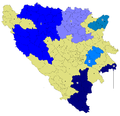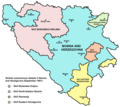Serb Autonomous Regions
From August 1990 to November 1991, during the breakup of Yugoslavia, several Serb Autonomous Regions,[1][2] or Districts[3] (sing. Serbian: Српска аутономна област (САО) / Srpska autonomna oblast (SAO)) were proclaimed in the Yugoslav republics of SR Croatia and SR Bosnia and Herzegovina in light of the possible secession of the republics from the Socialist Federal Republic of Yugoslavia. These were autonomous Serb-inhabited entities that subsequently united in their respective republic to form the Republic of Serbian Krajina in Croatia and the Republika Srpska in Bosnia and Herzegovina.
SAOs in Croatia[]

- SAO Kninska Krajina (later SAO Krajina)
- SAO Eastern Slavonia, Baranja and Western Syrmia (later Eastern Slavonia, Baranja and Western Syrmia)
- SAO Western Slavonia
SAOs in Bosnia and Herzegovina[]
The Serb Democratic Party established SAOs in Serb-inhabited territories. Between September–November 1991, six entities had been proclaimed.[4] The Serbs set up their own parliament, having left the Bosnian parliament in October 1991. The Serb parliament proclaimed the "Serb Republic" (Republika Srpska) on 27 March 1992.
- SAO Bosnian Krajina, first formed as the Autonomous Region of Krajina) in April 1991. It was the largest region, but after failure to merge with SAO Krajina in Croatia, it was renamed SAO Bosanska Krajina in September 1991.
- SAO North-Eastern Bosnia formed in September 1991; renamed in November 1991, and SAO Semberija i Majevica in December 1991.
- , formed in November 1991, never fully controlled its proclaimed territory.
- , planned from predominantly Bosniak and Croat municipalities in northern Bosnia, but not fully established.
- SAO Romanija, formed in September 1991, and SAO Birač, formed November 1991; combined in November 1991 as SAO Romanija-Birač.
- SAO Herzegovina (also known as SAO Eastern Herzegovina), formed in September 1991.

SAOs in Bosnia and Herzegovina (Autumn 1991)

SAOs in Bosnia and Herzegovina (September 1991)

SAOs in Bosnia and Herzegovina (November 1991)
References[]
- ^ Marko Attila Hoare (2004). How Bosnia armed. Saqi Books in association with the Bosnian Institute. ISBN 978-0-86356-367-6.
- ^ Charles W. Ingrao; Thomas A. Emmert (15 September 2012). Confronting the Yugoslav Controversies: A Scholars' Initiative. Purdue University Press. pp. 125–. ISBN 978-1-55753-617-4.
- ^ John Oppenheim; Willem-Jan van der Wolf; Global Law Association (2003). Global war crimes tribunal collection. Global Law Association.
- ^ Nina Caspersen (15 January 2010). Contested Nationalism: Serb Elite Rivalry in Croatia and Bosnia in the 1990s. Berghahn Books. pp. 82–. ISBN 978-1-84545-791-4.
Further reading[]
- Stefan Grubač (1993). Srpske teme, 1989-92. ZIZ.
- Dobrica Ćosić; Ana Ćosić-Vukić (2009). Srpsko pitanje u XX veku: lična istorija jednog doba. Службени гласник. ISBN 978-86-519-0371-0.
- Autonomous regions
- History of the Serbs of Croatia
- History of the Serbs of Bosnia and Herzegovina
- Yugoslav Wars
- Serb organizations
- 1990 in Yugoslavia
- 1991 in Yugoslavia
- Political history of Republika Srpska
- Ethnic organizations based in Yugoslavia
- Serbian nationalism in Bosnia and Herzegovina
- Serbian nationalism in Croatia
- Serb Democratic Party (Bosnia and Herzegovina)


